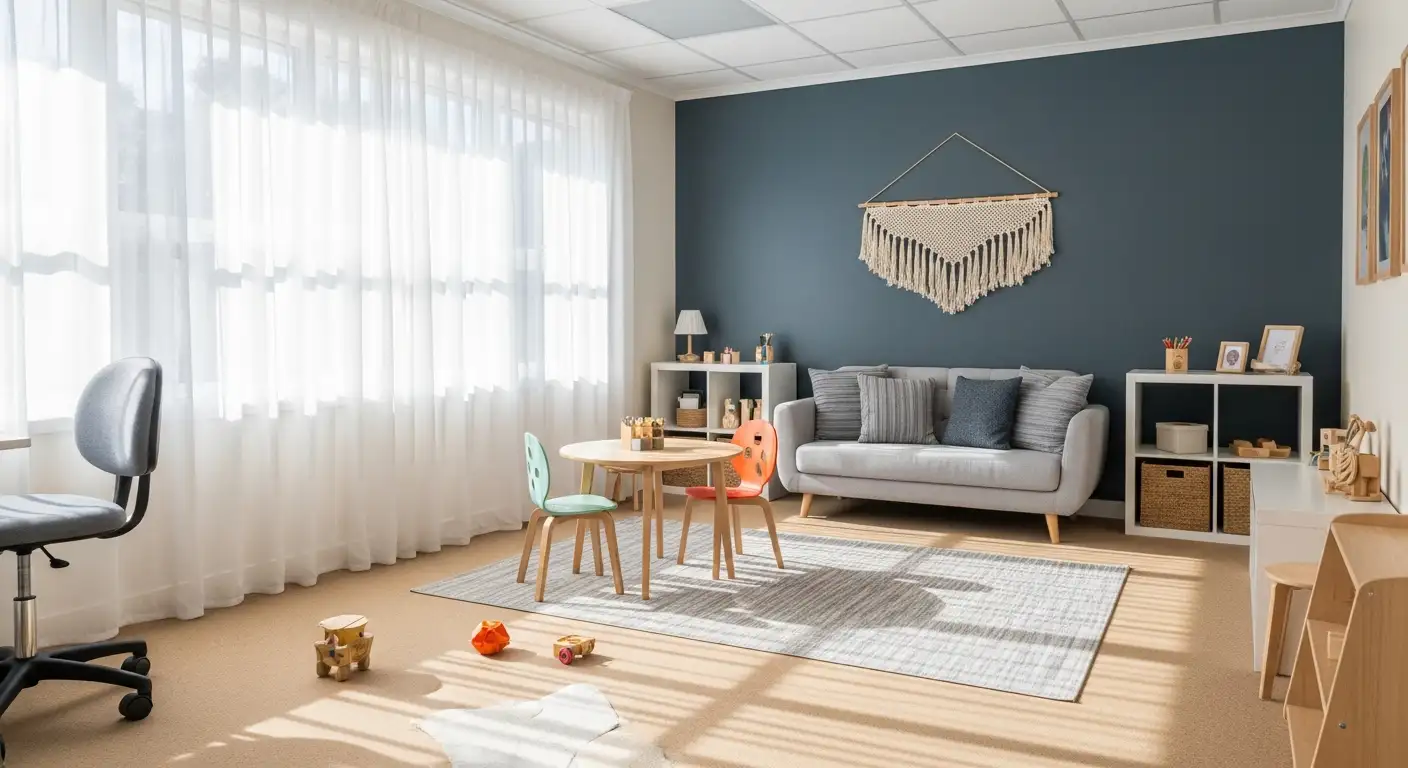Understanding the Impact of ABA on Social Development in Autism
Autism spectrum disorder (ASD) often presents challenges in social interaction, making peer relationships a significant focus for intervention. Applied Behavior Analysis (ABA) stands out as a scientifically supported approach that promotes the development of social skills essential for meaningful peer connections. This article explores how ABA therapy facilitates healthy peer interactions, the techniques employed, and the evidence underpinning its effectiveness.
The Foundations of ABA in Social Skill Development
Applied Behavior Analysis (ABA) has proven to be an effective approach in fostering social skills among children with autism. Its core principles revolve around understanding how behavior functions and how it can be changed through systematic methods. One of the main strategies used is task analysis, which involves breaking down complex social behaviors into smaller, manageable steps. This technique allows therapists and educators to teach each component thoroughly before moving on to more advanced skills.
ABA employs a variety of techniques and strategies to improve social skills and peer interactions. These include social skills training that systematically deconstructs behaviors such as initiating conversations, turn-taking, and maintaining eye contact. Visual supports like schedules, social stories, and comic strip conversations help children interpret social cues and understand expectations.
Role-playing and modeling are essential tools within ABA. Through structured practice, children can rehearse appropriate responses and behaviors in a safe setting before generalizing these skills to real-life situations. Small group activities and peer-mediated interventions further support natural social interactions and help children develop meaningful peer relationships.
Reinforcement is at the heart of ABA, encouraging children to practice and sustain desirable behaviors. Positive praise, rewards, and consistent feedback motivate children to engage more actively in social exchanges. Continuous data collection and assessment facilitate individualized programs, ensuring that interventions target each child's unique needs and promote skill generalization.
Parental involvement also plays a critical role. Training families to reinforce social skills at home ensures consistency across environments, which is vital for maintaining progress. Overall, ABA integrates multiple teaching techniques tailored to behavioral goals, making it a well-rounded approach for enhancing social functioning in children with autism.
Empirical Evidence Supporting ABA's Effectiveness
What is the evidence for the effectiveness of ABA in fostering social skills among children with autism?
Applied Behavior Analysis (ABA) is widely regarded as a scientifically supported approach for improving social skills in children with autism. Numerous research studies have validated its impact, showing consistent and significant gains in social behavior, communication, and interaction skills.
Many of these studies utilize rigorous experimental designs, such as ABAB single-case experiments, which help establish a clear link between the intervention and observed improvements. Data from these studies typically reveal moderate to large effect sizes, indicating meaningful changes in children’s social engagement and peer interactions.
ABA techniques, including modeling, prompting, reinforcement, and task analysis, are tailored to individual needs. These strategies help children learn how to initiate conversations, maintain peer relationships, and express emotions effectively.
Furthermore, interventions often include peer-mediated approaches, where typically developing peers are trained to facilitate natural social interactions. Such methods not only increase the frequency of peer exchanges but also encourage more complete, multimodal, and egalitarian interactions.
Research shows that when these ABA techniques are incorporated into naturalistic settings like playgrounds and classrooms, skills tend to generalize more effectively outside therapy contexts. Parental involvement and visual supports, such as social stories and schedules, additionally support sustained progress.
In summary, extensive scientific evidence strongly supports ABA as an effective intervention to enhance social functioning in children with autism. Its flexibility, individualized nature, and empirical backing make it a leading choice for fostering meaningful peer interactions and social development.
| Study Type | Main Findings | Notable Techniques Used |
|---|---|---|
| Controlled studies | Significant social skill improvements | Reinforcement, modeling, prompting |
| Meta-analyses | Large effect sizes in social behavior | Discrete trial, natural environment training |
| Naturalistic studies | Skills generalize outside therapy settings | Peer-mediated, visual supports |
| Long-term follow-ups | Maintained social gains | Parent training, consistent practice |
This evidence underscores the importance of implementing evidence-based strategies like ABA to support social skill development and peer interaction among children with autism.
Techniques and Strategies in ABA for Social Skills Enhancement

What techniques and strategies are used in ABA to improve social skills and peer interactions?
Applied Behavior Analysis (ABA) employs a variety of effective methods to enhance social interactions among children with autism. Central to these strategies is breaking down complex social behaviors into small, manageable steps through task analysis. This detailed approach allows children to learn skills gradually, boosting confidence and competence.
Visual supports such as social stories, social scripts, and comic strip conversations play a critical role. These tools help children understand social norms, interpret facial expressions, and practice responses within a predictable framework. Additionally, ABA incorporates role-playing, modeling, and video modeling to simulate real-life interactions. These methods provide children with clear examples of appropriate social behaviors, which they can imitate and practice.
Group activities like small social skills groups serve as natural settings where children can apply what they learn. During these activities, positive reinforcement encourages behaviors like sharing, turn-taking, and making eye contact. Consequently, children are motivated to engage socially, leading to greater consistency and improvement.
Assessment tools guide the development of individualized programs, ensuring that interventions target specific social deficits relevant to each child's developmental level. This customization fosters better generalization of skills across different environments.
Parental involvement and routine reinforcement at home further support progress. Consistent practice in various settings ensures that social skills become embedded in daily life, helping children develop meaningful peer relationships.
Use of visual supports and social stories
Visual supports like schedules and social stories make social situations clearer and easier for children with autism. These visuals help in understanding expectations and interpreting social cues effectively.
Positive reinforcement and naturalistic teaching
Celebrating successes through praise or rewards boosts motivation. Naturalistic teaching leverages everyday interactions, making learning contextually meaningful.
Peer-mediated interventions and natural environments
Pairing children with autism with typically developing peers creates authentic opportunities for interaction. Practicing social skills in natural settings like playgrounds helps with skill generalization and confidence building.
Enhancing Social Interactions Through Peer-Mediated Interventions

How does ABA therapy support healthy peer interactions in children with autism?
Applied Behavior Analysis (ABA) therapy is a well-recognized, evidence-based approach to improving social skills in children with autism. It employs a variety of techniques such as structured social skills training, modeling, prompting, and naturalistic teaching methods to encourage appropriate communication and social behaviors.
One core strategy involves pairing children with autism with typically developing peers during activities. These peer-mediated interventions facilitate natural, meaningful interactions. By engaging in small groups and shared activities, children learn essential social skills like turn-taking, sharing, initiating conversations, and recognizing social cues.
Positive reinforcement is a cornerstone of ABA, used to reward desirable behaviors and motivate children to practice new skills. Activities such as role-play, games, and collaborative projects provide opportunities for children to apply what they’ve learned in real-world scenarios, promoting generalization of skills across different environments.
Parental involvement is also crucial. By incorporating family and peer participation, ABA therapy supports consistent learning and builds a supportive network that fosters social confidence.
Overall, ABA aims to create inclusive, supportive settings where children with autism can develop healthy peer relationships, improve their social confidence, and experience emotional growth. This comprehensive approach helps break down social barriers and fosters a sense of belonging and acceptance.
The Role of Environmental and Contextual Factors
Supportive social environments are crucial for fostering positive peer interactions among children with autism. A study utilizing a supports-based intervention demonstrated that when environmental factors were optimized, the frequency of communicative offers between a minimally verbal autistic student and a nonautistic peer increased significantly.
Natural settings such as playgrounds and classrooms play a vital role in this process. These environments provide opportunities for children to observe, imitate, and engage in social behaviors within real-life contexts, which is essential for the generalization of social skills. Engaging in shared activities like games, collaborative projects, and casual conversations helps children develop confidence and competence in social interactions.
Research indicates that skill transfer is most successful when social skills learned through interventions are practiced in environments where children naturally interact. Visual supports like schedules, social stories, and cues further aid understanding and participation, making social exchanges more accessible.
In a recent study published in Focus on Autism and Other Developmental Disabilities, a visual inspection of data revealed a moderate effect size linking social supports to increased peer communication behaviors. Discourse analysis noted that after supports were implemented, interactions became more complete, multimodal, and egalitarian. Children were more able to share ideas, use multiple forms of communication such as gestures and speech, and interact on equal terms.
These findings underscore the importance of designing environments that are conducive to social learning. When children with autism are embedded in consistent, encouraging settings, their ability to develop meaningful peer relationships improves.
To encapsulate, creating autism-friendly environments in schools and playgrounds fosters natural social learning opportunities. Effective intervention strategies involve integrating visual supports, naturalistic teaching, and peer-mediated approaches. These strategies not only promote the generalization of social skills but also contribute to increased emotional well-being and social participation.
| Aspect of Environment | Role in Peer Interaction | Supporting Evidence |
|---|---|---|
| Natural Settings | Facilitate real-life practice of social skills | Study shows increased communication with peer support in classrooms and playgrounds |
| Visual Supports | Enhance understanding and participation | Evidence indicates improved engagement and interaction |
| Peer-Mediated Interventions | Promote authentic social exchanges | Data supports increased completeness and egalitarian nature of interactions |
| Environmental Design | Reduce social barriers, encourage sharing | Discourse analysis demonstrates more multimodal and reciprocal exchanges |
Understanding environmental influences encourages the development of comprehensive strategies that integrate natural social contexts, maximizing the social participation of children with autism.
Supporting Emotional and Self-Advocacy Skills
How does ABA therapy support healthy peer interactions in children with autism?
Applied Behavior Analysis (ABA) therapy plays a vital role in fostering positive peer interactions for children with autism. It uses evidence-based techniques like structured social skills training, which involves small group activities such as role-playing, modeling, and collaborative exercises. These methods teach children how to communicate effectively, take turns, and recognize social cues—all essential for meaningful social exchange.
In addition, ABA incorporates naturalistic teaching approaches, including peer-mediated interventions where typically developing peers are trained to encourage and model appropriate social behaviors. Such interactions create natural opportunities for children with autism to practice and generalize social skills in real-world settings, like playgrounds and classrooms.
Positive reinforcement is central to ABA, encouraging children to engage in social behaviors by rewarding successful interactions with praise or tangible rewards. This reinforcement builds motivation and confidence to participate actively. Moreover, parental and peer involvement further enhances opportunities for social growth. Family members are encouraged to reinforce social skills at home, ensuring consistency and ongoing development.
Ultimately, ABA focuses on creating inclusive, supportive environments that help children with autism form meaningful peer relationships. It aims to develop social confidence, reduce social anxiety, and promote emotional well-being, contributing to overall social development.
The Importance of Early Intervention and Family Involvement

What are the benefits of ABA therapy for developing healthy peer interactions in children with autism?
Applied Behavior Analysis (ABA) therapy is widely recognized as an effective method for promoting social skills in children with autism. One of its primary benefits is its ability to enhance social communication skills, which are often challenging for autistic children. Through structured activities like role-playing, social stories, and video modeling, ABA provides safe and supportive environments where children can learn to initiate conversations, understand social cues, and interpret emotions.
Positive reinforcement strategies are a cornerstone of ABA, encouraging children to practice desired behaviors such as sharing, turn-taking, and cooperation. These skills are fundamental for forming and maintaining friendships. ABA also employs tools like picture exchange systems and communication devices to overcome language barriers, ensuring children can participate more fully in peer interactions.
The individualized, data-driven nature of ABA allows therapists to tailor interventions to each child's needs, tracking progress and adjusting strategies as required. This personalized approach helps children build confidence and develop meaningful relationships, fostering their ability to engage successfully with peers in diverse social settings.
Strategies for involving families
Family involvement is a vital aspect of successful ABA interventions. Engaging parents and caregivers not only ensures consistency across home and social environments but also reinforces learned skills outside formal therapy sessions.
Effective strategies include training families on reinforcement techniques, communication strategies, and the use of visual supports like social stories or schedules. Regular communication with therapists helps families understand their child's progress and ways to support social skill development.
Involving families in social activities and community outings provides opportunities for children to apply skills in natural settings. This practice promotes generalization of social skills, making interactions more spontaneous and meaningful.
Early intervention programs that incorporate family participation tend to produce more significant improvements in social functioning. Educating families about autism fosters understanding, acceptance, and empathy, creating a supportive environment for the child's social growth.
Additional insights on early intervention and family involvement in ABA for autism
Research indicates that starting ABA therapy early in a child's development yields better social, communicative, and adaptive outcomes. Family engagement amplifies these benefits by providing consistent reinforcement and opportunities for practice at home.
Parents who are active participants in ABA programs often report increased confidence in managing social situations and encouraging positive peer interactions. This collaborative approach fosters a strong partnership between families and professionals, which is essential for sustained progress.
| Aspect | Description | Benefits |
|---|---|---|
| Early ABA intervention | Starts soon after diagnosis, focusing on foundational skills | Increased social adaptability, reduced behavioral challenges |
| Family involvement | Active participation in therapy and social facilitation | Consistent reinforcement, skill generalization, improved family dynamics |
| Strategies used | Training, social stories, community activities | Enhanced social understanding, peer relationship skills |
Supporting early and family-centered approaches creates a comprehensive framework that significantly improves peer interaction opportunities for children with autism, promoting social inclusion and lasting relationships.
Role of Visual Supports and Social Stories
What techniques and strategies are used in ABA to improve social skills and peer interactions?
Applied Behavior Analysis (ABA) employs various techniques to foster social skills among children with autism. Central to this approach is structured social skills training that simplifies complex social behaviors into manageable steps, making learning more accessible. Techniques like social narratives and social scripts are frequently used; these tools help children understand social norms and interpret nonverbal cues.
In addition, visual supports such as schedules, social stories, and comic strip conversations serve as visual cues that clarify social expectations and aid comprehension. Role-playing and modeling are integral, providing children with opportunities to practice interactions in a safe environment. Small group activities replicate real-life social settings, encouraging children to engage with peers while receiving positive reinforcement for desired behaviors like turn-taking, maintaining eye contact, and sharing.
Assessment tools and individualized programs are tailored to each child's specific needs, ensuring targeted progress. Active involvement of parents and caregivers reinforces these skills at home, promoting consistency. Overall, these strategies combined build confidence, foster social understanding, and lead to meaningful peer engagements.
Long-term Benefits and Social Integration

How does peer-mediated intervention support long-term social skills development?
Peer-mediated intervention, especially when combined with structured approaches like ABA therapy, can have lasting effects on a child's social skills. By encouraging participation in shared activities and fostering flexible, multimodal communication methods, children with autism learn to engage more naturally with their peers.
Research shows that such interventions not only increase the frequency of social interactions but also make these interactions more meaningful. For example, discourse analysis indicates that post-intervention, peer exchanges become more complete, multimodal, and egalitarian. This means interactions are richer, utilizing different communication modes like gestures, speech, and visual aids, and are more balanced in participation.
How are friendships and community participation built over time?
Building friendships is a fundamental goal of enhancing peer interactions. Through consistent, supportive interactions facilitated by interventions, children with autism develop stronger bonds, experience a sense of belonging, and are more integrated into their communities.
Early and ongoing social skill development, supported by evidence-based practices, helps children learn how to initiate conversations, share interests, and maintain friendships. These skills transfer across settings, whether at school, playgrounds, or community events, promoting inclusive participation.
What improvements in social functioning occur across different environments?
Data from intervention studies highlight significant improvements in social functioning across various settings. Children become more confident and competent in understanding social cues, interpreting facial expressions, and engaging in reciprocal communication.
Such improvements contribute to less social isolation and greater independence. The skills gained enable children to navigate complex social situations, adapt to different environments, and sustain positive peer relationships—crucial factors for long-term social integration.
How does ABA therapy contribute to sustained social growth?
ABA therapy, with its focus on positive reinforcement, task analysis, and modeling, facilitates the acquisition and generalization of social skills. When these skills are practiced in natural environments—like playgrounds and classrooms—they become more ingrained and usable outside therapy sessions.
Involving parents and caregivers further supports consistency and reinforcement at home, maximizing long-term benefits. The use of visual supports and social stories also helps children understand and apply social rules in diverse contexts.
| Aspect | Description | Impact |
|---|---|---|
| Social Skill Development | Techniques include role-playing, modeling, and reinforcement. | Builds confidence, encourages positive interactions |
| Peer Engagement | Pairing children with typically developing peers. | Facilitates natural social interactions |
| Environmental Adaptation | Practice in various settings, including community spaces. | Ensures skills are adaptable and generalizable |
| Family Involvement | Training parents to reinforce skills at home. | Strengthens and sustains social growth |
| Use of Visual Supports | Schedules, social stories, communication aids. | Enhances understanding and participation |
Final thoughts
The combination of structured interventions and naturalistic practice enables children with autism to develop their social functioning comprehensively. Over time, these efforts lead to improved ability to build friendships, participate actively in communities, and integrate socially across multiple environments.
The Protective Role of Peer Relationships and Social Support
How does supports-based intervention influence peer communication among autistic students?
A supports-based intervention has been shown to positively affect the frequency and quality of communicative offers between minimally verbal autistic students and their nonautistic peers. Using a single-case experimental ABAB design, researchers observed a clear link between the introduction of social supports and increased peer interactions.
Visual inspection of the data revealed a moderate effect, indicating that such interventions consistently promote more engaging social behaviors. Moreover, discourse analysis found that interactions became more complete, multimodal, and egalitarian—meaning that both children contributed more equally and used various modes like speech, gestures, or visual aids to communicate.
The intervention focused on encouraging participation in shared activities and promoting flexibility in communication modes, which facilitated more natural and inclusive peer exchanges. These strategies help create a more supportive environment where children with autism feel comfortable engaging and sharing.
How does peer interaction support social development in children with autism?
Research published in "Focus on Autism and Other Developmental Disabilities" confirms that peer interactions play a vital role in developing social skills in children with autism. Despite challenges such as difficulty interpreting facial expressions, understanding emotions, and engaging in reciprocal communication, peer interactions offer valuable opportunities.
Through observing, imitating, and participating in shared social behaviors, children with autism can build important skills necessary for building friendships and social integration. Engaging with peers who share common interests further enhances motivation and sustains engagement.
Conversations and collaborative activities contribute to the improvement of pragmatic language, expression of thoughts and feelings, and overall communication skills. These interactions also foster a sense of belonging and acceptance, which is crucial for emotional well-being. Supportive peer relationships can serve as protective factors, reducing anxiety and behavioral challenges.
What strategies are effective in facilitating peer interactions?
A combination of approaches enhances the development of peer relationships in children with autism. Structured social skills training, peer-mediated interventions, and creating inclusive, autism-friendly environments are highly effective. Incorporating positive reinforcement, technology tools, and early family involvement further supports social development.
Teaching peers about autism fosters greater acceptance, empathy, and inclusivity, helping to cultivate supportive social networks. The benefits extend beyond immediate social skills, leading to better social functioning, independence, and community integration.
How does ABA therapy assist in improving peer interactions?
Applied Behavior Analysis (ABA) stands out as an evidence-based approach to develop social and peer-related skills. It involves creating safe, supportive social groups, often through small group activities like role-playing and modeling to reinforce desirable behaviors.
ABA employs task analysis to break complex social interactions into manageable steps, making learning accessible. Reinforcement strategies—like praise and rewards—encourage children to practice social behaviors regularly. Data collection ensures personalized adjustments, maximizing progress.
Peer-mediated interventions within ABA pair children with autism alongside typical peers, promoting naturalistic interactions. Practicing social skills in real-world environments such as playgrounds and classrooms ensures these skills transfer beyond structured sessions. Involving parents and caregivers solidifies learning at home, fostering consistency.
Visual supports like social stories aid comprehension and participation, making social skills tangible and understandable. Overall, ABA facilitates meaningful peer connections, improves confidence, and nurtures social competence.
How do environmental factors influence peer interactions?
The environment significantly impacts the opportunities and quality of peer interactions for children with autism. Supportive settings that emphasize inclusivity and understanding—such as autism-friendly classrooms—create natural contexts for communication.
Structured interventions, along with positive reinforcement and social supports, set the stage for successful social exchanges. Additionally, involving families and peers in intervention strategies reinforces the importance of social skills and acceptance.
By focusing on enhancing environmental aspects—from physical spaces to social norms—educators and therapists can improve participation, reduce social anxiety, and foster lasting friendships among children with autism.
| Strategies | Focus Areas | Outcomes |
|---|---|---|
| Supports-based intervention | Shared activities, multimodal communication | Increased peer offers, egalitarian interactions |
| ABA therapy | Role-playing, reinforcement | Improved social skills, peer relationships |
| Peer-mediated interventions | Pairing with typical peers | Natural social exchanges, better integration |
| Inclusive environments | Autism-friendly settings | Greater participation, acceptance |
| Parental involvement | Reinforcement at home | Sustainable social skill development |
Bridging the Gap: Building Social Skills Through Evidence-Based Interventions
The development of social skills and healthy peer interactions is crucial for children with autism to thrive socially and emotionally. ABA therapy, rooted in empirical evidence, offers comprehensive strategies—such as task analysis, modeling, role-playing, peer-mediated interventions, and the use of visual supports—that facilitate meaningful social engagement. By addressing individual needs and promoting inclusive environments, ABA not only enhances communication and social understanding but also fosters long-term relationships, emotional well-being, and community participation. With early intervention and continuous family involvement, children on the spectrum can develop the social competence necessary to form friendships, navigate social settings, and lead fulfilling lives.
References
- Effectiveness of a Supports-Based Approach to Peer ...
- Social Skills Development Through Peer Interaction for ...
- Working With ABA And Social Skills Groups For Autism
- The Effectiveness of ABA Therapy
- Supporting Sibling Relationships in Autism Families Using ...
- Effectively Teaching Social Skills in ABA
- Developing Social Skills Through ABA Therapy for Autism
- Social Skills Training in Applied Behavior Analysis? ASD











